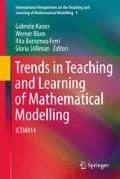Abstract
This chapter argues for a future-oriented, inclusion of Engineering Model Eliciting Activities (EngMEAs) in elementary mathematics curricula. In EngMEAs, students work with meaningful engineering problems that capitalise on and extend their existing mathematics and science learning, to develop, revise and document powerful models, while working in groups. The models developed by six groups of 12-year students in solving the Natural Gas activity are presented. Results showed that student models adequately solved the problem, although student models did not take into account all the data provided. Student solutions varied to the extent students employed the engineering context in their models and to their understanding of the mathematical concepts involved in the problem. Finally, recommendations for implementing EngMEAs and for further research are discussed.
Access this chapter
Tax calculation will be finalised at checkout
Purchases are for personal use only
References
English, L., & Mousoulides, N. (2009). Integrating engineering education in the middle school mathematics curriculum. In B. Sriraman, V. Freiman, & N. Lirette-Pitre (Eds.), Interdisciplinarity, creativity, and learning (pp. 165–175). The Montana Mathematics Enthusiast Monograph Series, Monograph 7. Charlotte: Information Age Publishing Inc.
Kaiser, G., & Sriraman, B. (2006). A global survey of international perspectives on modelling in mathematics education. Zentralblatt für Didaktik der Mathematik, 38(3), 302–310.
Lesh, R., & Doerr, H. M. (2003). Beyond constructivism: A models and modeling perspective on mathematics problem solving, learning and teaching. Mahwah: Lawrence Erlbaum Associates.
Lesh, R. A., & Zawojewski, J. S. (2007). Problem solving and modeling. In F. Lester (Ed.), Second handbook of research on mathematics teaching and learning (pp. 763–804). Greenwich: Information Age Publishing.
Miles, M., & Huberman, A. (1994). Qualitative data analysis (2nd ed.). London: Sage.
Mousoulides, N., & English, L. D. (2008). Modeling with data in cypriot and Australian classrooms. In O. Figueras, J. L. Cortina, S. Alatorre, T. Rojano, & A. Sepulveda (Eds.), Proceedings of the 32nd International Conference of the International Group for the Psychology of Mathematics Education, Vol. 3 (pp. 423–430). Morelia: University of Morelia.
Mousoulides, N., Sriraman, B., & Lesh, R. (2008). The philosophy and practicality of modeling involving complex systems. The Philosophy of Mathematics Education Journal, 23, 134–157.
National Academy of Sciences, National Academy of Engineering, and Institute of Medicine. (2007). Rising above the gathering storm: Energizing and employing America for a brighter economic future. Washington: The National Academies Press.
Organization for Economic Cooperation and Development (OECD) (2006). Education at a glance: OECD indicators 2006. Retrieved 2nd of June from http://www.oecd.org/document/52/0,3343,en_2649_39263238_37328564_1_1_1_1,00.html.
Petroski, H. (2003). Early education. American Scientist, 91, 206–209.
Zawojewski, J. S., Hjalmarson, J. S., Bowman, K., & Lesh, R. (2008). A modeling perspective on learning and teaching in engineering education. In J. Zawojewski, H. Diefes-Dux, & K. Bowman (Eds.), Models and modeling in engineering education: Designing experiences for all students. Rotterdam: Sense Publications.
Author information
Authors and Affiliations
Corresponding author
Editor information
Editors and Affiliations
Rights and permissions
Copyright information
© 2011 Springer Science+Business Media B.V.
About this paper
Cite this paper
Mousoulides, N.G., English, L.D. (2011). Engineering Model Eliciting Activities for Elementary School Students. In: Kaiser, G., Blum, W., Borromeo Ferri, R., Stillman, G. (eds) Trends in Teaching and Learning of Mathematical Modelling. International Perspectives on the Teaching and Learning of Mathematical Modelling, vol 1. Springer, Dordrecht. https://doi.org/10.1007/978-94-007-0910-2_23
Download citation
DOI: https://doi.org/10.1007/978-94-007-0910-2_23
Published:
Publisher Name: Springer, Dordrecht
Print ISBN: 978-94-007-0909-6
Online ISBN: 978-94-007-0910-2
eBook Packages: Humanities, Social Sciences and LawEducation (R0)

